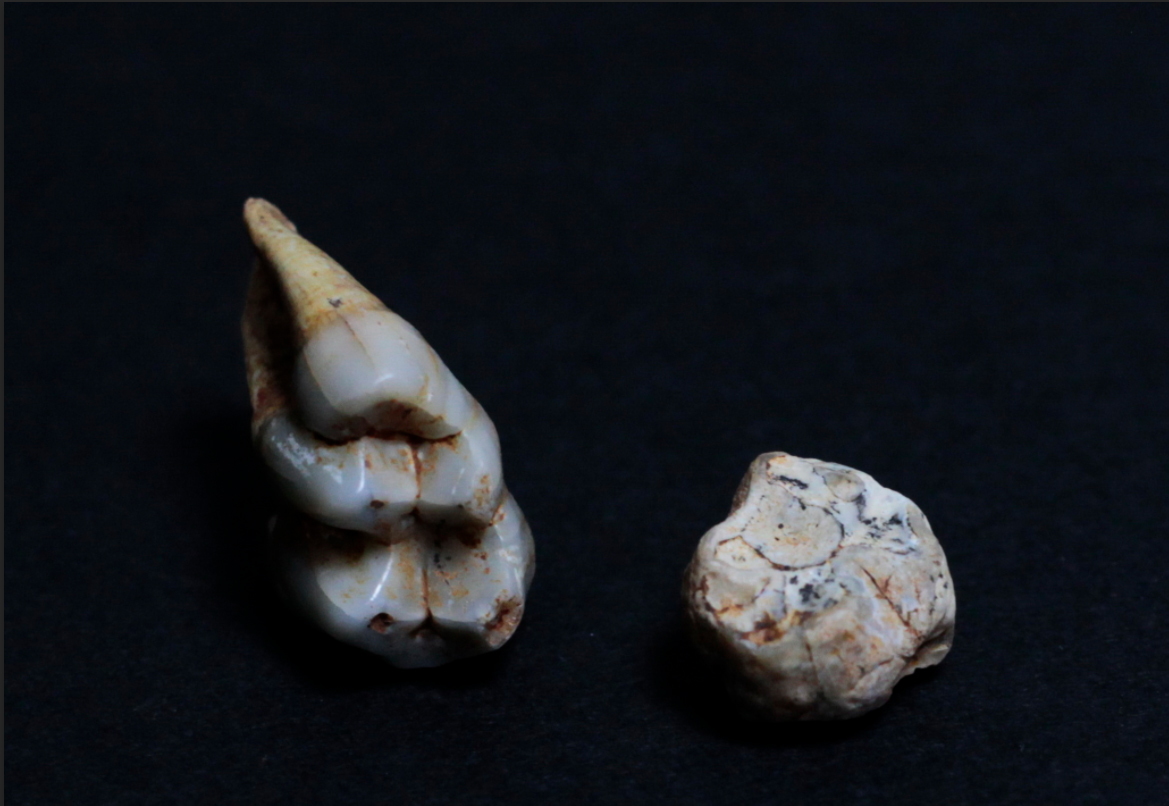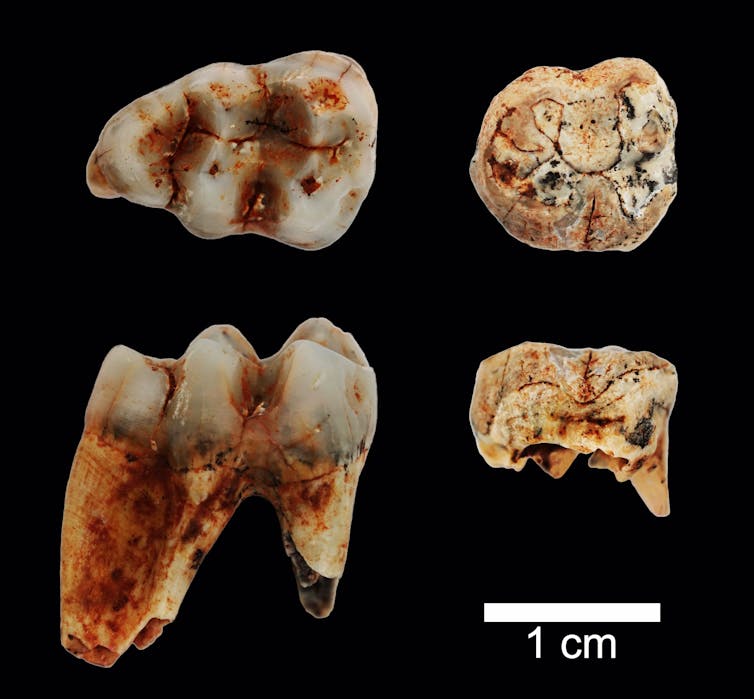
Two primate teeth from Ridjake, Serbia identified as Paradolichopithecus. Photo by Predrag Radović
Monkey fossils found in Serbia offer clues about life in a warmer world millions of years ago
Sparse trees cast long shadows as the morning sun rises over the grassy woodland clearing. Elephants and rhinos gather around a quiet watering hole. A troop of baboons starts chattering as they wake up, preparing for the sweltering heat the day will bring.
The scene is straight out of The Lion King, but this isn’t Africa — this is Eastern Europe at the end of the Pliocene epoch, three million years ago.
It’s a world that’s familiar to Predrag Radović, a paleontologist at the National Museum in Kraljevo, Serbia. Radović has studied fossils from extinct European elephants like Zygolophodon, a large mastodon with three-metre-long tusks, and Deinotherium, which looked like a modern African elephant, except that its tusks grew from its bottom jaw and curved downwards.
Radović has identified the remains of a 12.5 million-year-old whale from the Miocene epoch (5.3 million to 23 million years ago), when much of Europe was submerged beneath a vast inland sea. Now Radović is writing a report about a tooth from Stephanorhinus, an extinct rhinoceros from the Ice Age.
Monkey teeth
Recently, Radović invited me to collaborate on a paper about a new fossil tooth he was studying. Compared to rhinos and whales this tooth was small and unassuming, but that’s why it was so interesting: it belonged to a monkey!
The tooth came from a very rich paleontological site in the village of Ridjake, western Serbia. Soon afterwards, researchers from the Natural History Museum in Belgrade found a second, better-preserved tooth from the same kind of monkey. We analyzed the teeth and published our results in the Journal of Human Evolution.
The teeth belonged to Paradolichopithecus, a large, baboon-like monkey that lived during the Pliocene epoch, between 2.6 million and 5.3 million years ago. This is the first monkey fossil ever found in Serbia, but monkeys were common in Europe during the Pliocene. Paradolichopithecus fossils have already been found in Spain, France, Greece and Romania, and their range extended as far as China. Studying fossil monkeys like these can help us understand how ancient climates shaped primate evolution

Primate paradise
In many ways, the Pliocene epoch was a paradise for primates. The global climate was two to four degrees Celsius warmer and sea level was much higher. There was no permanent ice cap at the North Pole and boreal forests extended to the high Arctic.
European monkeys lived in humid, subtropical forests. This warmth was due in part to higher levels of atmospheric carbon dioxide — more than 400 parts per million, a number we’ve just recently reached again for the first time in three million years. In fact, some scientists have begun studying the Pliocene to help understand what our climate might look like if we fail to slow our current rate of global warming.
But for Europe’s Pliocene monkeys, a different kind of climate change was looming. The South American continent, which had been drifting northwards for millions of years, finally collided with the Caribbean plate, setting off a chain reaction that would permanently change the global climate. With North and South America connected for the first time, the flow of ocean water between the Atlantic and Pacific was cut off, redirecting global ocean currents.
The newly formed Gulf Stream began carrying warm water straight to Northern Europe, where it evaporated and then fell as rain and snow, diluting the salty Arctic Ocean enough that it was able to freeze. By three million years ago, the Arctic ice cap had begun to form, driving the global climate into an Ice Age.
The last primate
In continental Europe, the humid, subtropical environments began to get drier. Paradolichopithecus was able to weather the climate changes pretty well: the earliest fossils from Romania came from a humid, forested environment, but later fossils from France and Spain show that the animals were able to adapt to drier grassland conditions.
But when the Pliocene ended and the Pleistocene epoch began, 2.6 million years ago, the Ice Age took hold of the planet. The global climate settled into a cycle of glacial and interglacial periods, during which giant ice sheets would repeatedly expand and retreat over much of the northern continents. The Pleistocene drove all the primates in Europe to extinction — except one.
Homo, the human genus, emerged in Africa around the beginning of the Pleistocene and quickly spread out across the Old World. Early humans were able to adapt to environments other primates could not by creating tools, developing seasonal strategies for finding food and controlling fire. By the Middle Pleistocene, several different species of humans were living all across Africa, Asia and Europe.
Of all the exotic animals that Radović studies, these are the most interesting. As part of an international team — led by Dušan Mihailović, an archaeology professor at the University of Belgrade, and Mirjana Roksandic, a biological anthropologist at the University of Winnipeg — Radović and I helped to identify the first Neanderthal remains from Serbia and the Central Balkans.
Read more: A Neanderthal tooth discovered in Serbia reveals human migration history
Balkan refuge

The village of Ridjake, western Serbia, where two fossil monkey teeth were found. Predrag Radović, Author provided
The Balkan region is critical for understanding how humans and other animals responded to climate change during the Pleistocene because it served as a refuge during glacial periods. As the ice sheets expanded across northern parts of Europe, populations were funnelled into the valleys and floodplains of the Central Balkans where they were forced to adapt to new environments — or face extinction.
In the end, even the genus Homo succumbed to the Pleistocene. When the last glacial cycle ended and the Holocene epoch began, 12,000 years ago, every human species had disappeared except one.
It’s tempting to think there’s something special about us that allowed us to survive when others didn’t, but we were probably just lucky. The track record of primates in the Plio-Pleistocene should remind us how much climate change has influenced the course of human and primate evolution, and how precarious our relationship with the climate can be.
Humans are a true Ice-Age animal. The northern ice cap has never melted since it formed three million years ago so the Ice Age hasn’t technically ended. But if the current rate of human-influenced climate change keeps up, we will be thrust into a world our genus has never known. Studying our Pliocene relatives like Paradolichopithecus can offer us a perspective on what that world may be like.
This article from Joshua Allan Lindal, PhD student in Anthropology at the University of Manitoba, was published by The Conversation.
Research at the University of Manitoba is partially supported by funding from the Government of Canada Research Support Fund.






